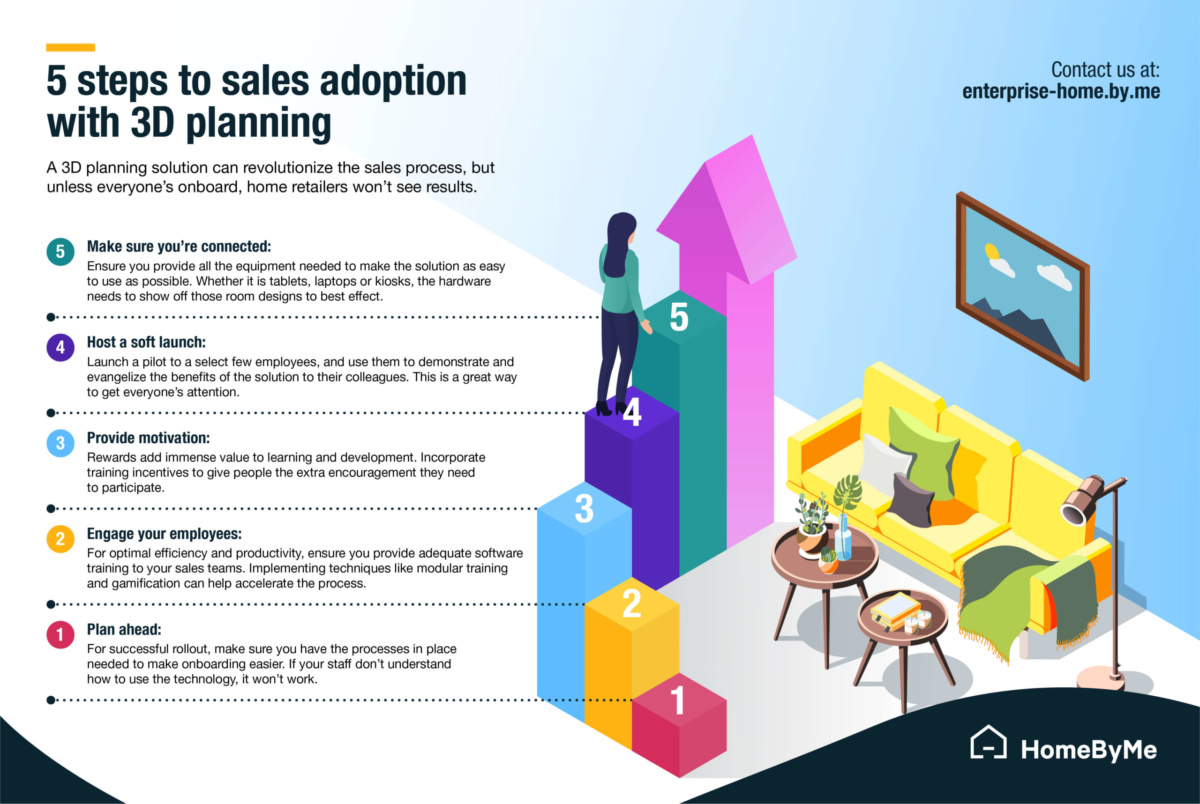Customer Experience September 17, 2021
The HomeByMe 3D planning solution: 5 steps to successful sales adoption

Implementing a 3D planning solution does not end once the technical rollout has been completed.
In fact, the most important part of the deployment process comes afterwards: getting sales professionals to use the solution. How can organisations get their busy sales representatives to invest the time needed to get to grips with this new technology and use it in their day-to-day customer interactions?
While 55% of C-suite respondents to a Forbes survey said that sales enablement solutions were the top technology investments for boosting sales productivity, when it comes to actual usage the numbers are often disappointingly low. In a separate study, 83% of senior executives explained that their biggest challenge was getting their staff to use the software. Across the board, many businesses struggle with low adoption rates of new technical tools among the sales force, for a variety of reasons. Let us examine these reasons first, and then move on to simple steps by which the company could ensure successful sales adoption.
What lies behind a reluctance to change or adopt new software solutions?
- Time-pressure – Sales representatives on the shop floor need to achieve the maximum throughput possible. Within this context, one of the most important barriers is the fear that the new solution will slow the process down.
- Focussed on closing deals – Salespeople’s top priority is to close deals. By and large, they view every new software solution through this lens and if it does not help them close deals from the outset, they will not want to spare time on it.
- ‘If it isn’t broken, why fix it?’ – This is a common refrain not only among salespeople but among staff in any organization who are faced with embracing new technologies. If their current ways of working have served them well so far, and they are efficient with their existing tools, they can be reluctant to change.
Having understood some common barriers to change, it is essential for organizations to ensure that a 3D planning solution, whether it is launched for the first time or replacing an older one, is introduced in a manner that ensures widespread adoption.
1 – Develop your roll out plan early
It is not uncommon for organizations to purchase, install, test and roll out a new software platform before introducing it to the users it is intended for. To ensure faster and more widespread adoption, it’s a good idea to involve sales teams much earlier on in the process, watching demos, and even involving them directly in trials and testing. Quite apart from generating anticipation, this approach will add value and identify any customization and adaptation that needs to be made early on in the process.
2 – Creative ways to train your team
Training is essential in the rollout of a 3D planning solution. While the HomebyMe 3D planning tool is so intuitive that consumers can use it without any prior training, the right training will ensure that sales teams come onboard fast and are empowered to use it to its best potential. There is a vast array of training techniques that home retailers can employ in this context – from lecture-style sessions in person, to small groups on the shop floor, to online. Gamification, combined with incentives, makes training fun. It is extremely popular in this context and often results in nearly nine-out-of-ten individuals who receive gamified training feeling motivated afterwards.
3 – Communicate what’s in it for them
HomebyMe’s 3D planning solution is designed from the outset to help sales reps close more deals, faster, and move customers at a faster rate through the purchase cycle. For a successful launch, a little internal marketing might be required. By inspiring sales teams with what the solution can achieve, home retailers can ensure that teams understand its potential, thus speeding up adoption. Showcasing the high-quality room renders that come out of the HomebyMe 3D planning solution, for example, could be enough to capture sales teams’ attention. In the same vein, companies should also ensure that sales reps understand that the solution in fact speeds up the room design process, making it even easier to make changes at customers’ requests.
4 – Monitor, showcase and inspire results
There is a small core of early adopters in any organisation who will be the most enthusiastic about any new solution. They will explore its features, get up to speed quickly and enjoy using it with customers. It is always inspiring to showcase these early adopters and the results they achieve. Use them or senior leaders within the company as ambassadors, make training videos with them, and encourage them to share best practice. Another approach might be to do a soft launch in the form of a pilot with a few volunteers from the sales team, learn and showcase their experiences and then roll out the solution to all frontline sales staff. The HomebyMe 3D planning solution is so simple that it can be used by consumers in the comfort of their own homes – all that’s needed is a little inspiration!
5 – Make adoption easy, providing the right equipment and connectivity
Organizations can get the most out of their cloud-based 3D planning solution if they have the internet connectivity and IT equipment in place that make for a great user experience. Nothing kills usage as quickly as the frustration of having to wait for pages to load or render, sometimes with impatient customers at hand. Home retailers must ensure that sales reps have the right equipment at hand to showcase their catalogue in the best light possible. The good news is that the HomebyMe 3D planning solution works perfectly in any IT environment, even hybrid ones including desktop computers, laptops, handheld devices and kiosks.
Conclusion
3D planning solutions are today widely considered essential for sales professionals to bring home improvement projects to life, inspire consumers and move them smoothly from ‘consideration’ to ‘purchase’, and planning for effective adoption is an essential part of the rollout. A 2018 Technology at Work study by PwC, which surveyed 12,000 workers around the world, found that 29 percent of employees are motivated to use new technology because it helps them do their work more easily. With a little advance planning, home retailers can ensure that their investment in advanced 3D planning solutions is received positively by the sales teams that it is intended for.



